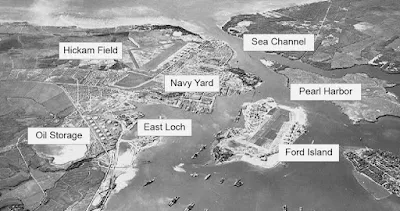To General Short
Negotiations with Japanese appear to be terminated to all practical purposes with only the barest possibilities that the Japanese Government might come back and offer to continue. Japanese future action unpredictable but hostile action possible at any moment. If hostilities cannot, repeat cannot, be avoided the U. S. desires that Japan commit the first overt act. This policy should not, repeat not, be construed as restricting you to a course of action that might jeopardize your defense. Prior to Japanese hostile action you are directed to undertake such reconnaissance and other measures as you deem necessary but these measures should be carried out so as not, repeat not, to alarm the civil population or disclose intent. Report measures taken. Should hostilities occur, you will carry out task signed in Rainbow Five as far as they pertain to Japan. Limit dissemination of this highly secret information to minimum essential officers.”
To Admiral Kimmel
“Consider this dispatch a war warning. The negotiations with Japan in an effort to stabilize conditions in the Pacific have ended. Japan is expected to make aggressive move within the next few days. An amphibious expedition against either the Philippines, Thai, or Kra Peninsula or possibly Borneo is indicated by the number and equipment of Japanese troops and the organization of their naval task forces. You will execute a defensive deployment in preparation for carrying out the tasks assigned in WPL-46 only. Guam, Samoa and Continental Districts have been directed to take appropriate measures against sabotage. A similar warning is being sent by the War Department. Inform naval district and Army authorities. British to be informed by Spenavo.”
Analysis
One message says negotiations have ended and the other says they may continue.
The Navy message emphasizes conflict and the Army message avoiding conflict.
The Navy message points attention away from Hawaii and mentions sabotage. The Army message says not to alarm the civilian population which means the lowest level of alert.
The Navy plan implements War Plan WPL-46 only, which forced Kimmel to use the few long-range patrol planes he had to scout the Marshall Islands to the southwest.
The Army message forbids the first overt act. Those are the words of FDR. They are also words that denote knowledge of the coming attack, because Hawaii wasn’t about to attack Japan.
The sabotage fig leaf was to distract the Hawaiian commanders from understanding the meaning of ‘overt act.’ But no one could allow sabotage, so it cannot have referred to that. What ‘overt act’ do you think FDR was referring to? Since attacking Japan and sabotage were impossible, that leaves only one possibility—Japan attacking Hawaii. The words “overt act” prove that FDR knew Japan would attack Hawaii.
The President’s own commission on Pearl Harbor declared that the Hawaiian commanders needed to “consult and confer with the other respecting the meaning and intent of the warnings” because they were so confusing. These messages were held by the Roosevelt administration as sufficient warning to Hawaii both before and after 7 December. No other defense was raised for denying IQ and not sending warnings to Hawaii. The Navy Court and Army Board found them totally inadequate, as indeed they are.
 |
| Radar Plot from Station Opana, Pearl Harbor, Hawaii, ca. 1941. |
 |
| General Short. |
 |
| Admiral Kimmel. |
 |
| A 75-mm gun M1917A1 in a camouflaged position in Hawaii. |
 |
| Rear Admiral Patrick L. Bellinger, Pearl Harbor's Air Defense officer, who predicted the Japanese attack. |
 |
| Ford Island, October 10, 1941. |
 |
| An aerial view of Battleship Row after the attack. |









No comments:
Post a Comment